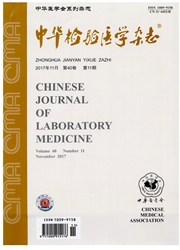

 中文摘要:
中文摘要:
目的探讨用低变性温度共扩增PCR(COLD-PCR)方法提高BCR—ABL1融合基因激酶区耐药突变检测灵敏度的可行性。方法本研究为实验诊断研究。设计常规巢式PCR(CN—PCR)和COLD—PCR方案扩增BCR—ABL1激酶区全长,扩增产物纯化后用Sanger测序法检测激酶区突变(KDM)。采集32例经伊马替尼(IM)治疗并出现耐药的慢性粒细胞性白血病(CML)患者和20例初诊CML患者外周血或骨髓标本,用上述2种方案检测标本中的KDM。用PCR扩增和基因克隆方法鉴定患者标本中KDM所占比例。制备含不同KDM比例的标准品,对比分析2种方法的检测灵敏度。结果32例IM耐药患者中,共检出15种KDM。其中用CN—PCR方法检出23例(71.9%)KDM阳性,用COLD—PCR检出28例(87.5%)KDM阳性。在20例初诊CML患者中,用CN—PCR未检出KDM,用COLD—PCR方法检出1例有P.E459K突变,突变型基因比例为3.5%。对于16种不同类型的KDM,COLD—PCR方法可提高检测灵敏度4~12倍。结论用COLD—PCR方法可有效提高BCR—ABL1激酶区耐药突变的检测灵敏度,有助于早期发现耐药突变。(中华检验医学杂志,2013,36:246-251)
 英文摘要:
英文摘要:
Objective To evaluate the feasibility of the co-amplification using a low denaturation temperature PCR (COLD-PCR) method in improving the detection of BCR-ABL1 fusion gene kinase domain drug-resistant mutation. Methods Conventional nested PCR (CN-PCR) and COLD-PCR protocol were designed to amplify full-length of BCR-ABL1 kinase domain. PCR products were purified and then Sanger sequenced to detect BCR-ABL1 kinase domain mutation (KDM). 20 newly diagnosed CML patients and 32 Imatinib (IM) resistant patients were chosen and peripheral blood or bone marrow samples were collected. PCR products of the clinical specimens were purified and then cloned to evaluate the proportion of the KDM allele. Standard samples with different proportion of KDMs were prepared using T-A vectors with KDM and wild type BCR-ABL1 kinase domain sequence, and then CN-PCR, COLD-PCR and Sanger sequencing were performed to compare the detection sensitivity. Results In the 32 IM-resistant patients, 23 were identified KDM-positive using CN-PCR and 28 KDM-positive using COLD-PCR. In the 20 newly diagnosed CML patients, none was identified KDM-positive using CN-PCR and 1 was identified carrying a lower proportion of KDM using COLD-PCR. For 16 different types of KDMs, COLD-PCR method could improve the detection sensitivity 4 - 12 times. Conclusion Detection sensitivity of BCR-ABL1 drug-resistant kinase domain mutation can be effectively improved by using COLD-PCR method and may contribute to early detection of resistance KDMs. ( Chin J Lab Meal,2013,36:246-251 )
 同期刊论文项目
同期刊论文项目
 同项目期刊论文
同项目期刊论文
 期刊信息
期刊信息
